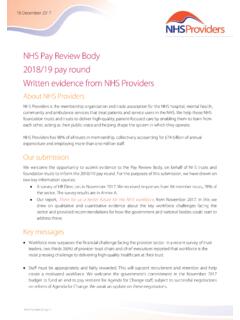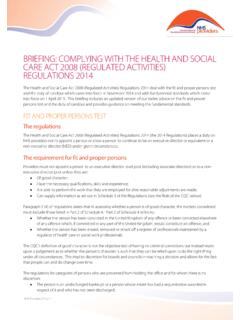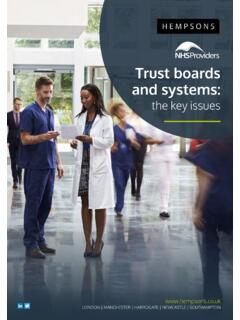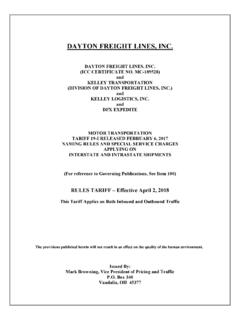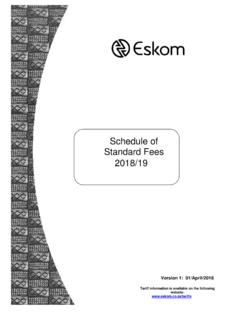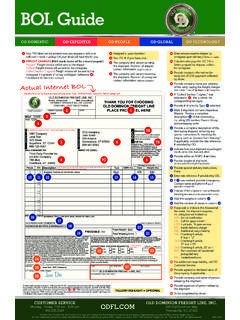Transcription of 2018/19 PLANNING GUIDANCE: NHS PROVIDERS …
1 2 February 2018 NHS PROVIDERS | ON THE DAY BRIEFING | Page 1 2018 / 19 planning guidance : NHS PROVIDERS ON THE DAY BRIEFING Today s PLANNING guidance is a refresh of plans already prepared under the two-year NHS Operational PLANNING and Contracting guidance 2017-2019. It sets out detail of how the additional funding from the November 2017 budget will be allocated and the developments in national policy with regards to system level collaboration. Documents published include: Refreshing NHS plans for 2018 -19 ( PLANNING guidance ) Commissioner Sustainability Fund and financial control totals for 2018 -19: guidance Revised CCG allocations 2018 -19 and accompanying notes NHS foundation trust annual reporting manual (FT ARM) 2017/18 (published earlier in the week) KEY HEADLINES The A&E performance recovery trajectory has been pushed back one year. Trusts will be expected to meet 90% by September 2018 , and return to 95% by March 2019.
2 On the referral to treatment standard, the expectation is that the waiting list should not be any higher in March 2019 than in March 2018 , alongside the expectation to halve the number of patients waiting 52 weeks in the same period. The Sustainability and Transformation Fund is to become the provider Sustainability Fund (PSF), with total funding of (up from currently). Access to 30% of the fund remains linked to A&E performance. A new 400m commissioner sustainability fund (CSF) will also be introduced to enable CCGs to return to in-year financial balance. The eight shadow Accountable Care System sites and two devolved health and care systems are now to be known as Integrated Care Systems (ICS). ICSs are expected to prepare a single system operating plan and to work within a system control total. They are expected to move to a more autonomous regulatory relationship with NHS England and NHS Improvement over time.
3 The guidance states that there will be no additional winter funding in 2018 /19. Systems are required to produce a winter demand and capacity plan with actions and proposed outcomes. guidance on submitting these winter plans will be available by March 2018 . The two-year National Tariff Payment system is unchanged, with local systems encouraged to consider local payment reform in certain areas. There is no new detail on how funding for the lifting of the pay cap will be administered. Trusts are urged, however, to ensure their workforce plans are robust as they will be used to inform pay modelling nationally. NHS PROVIDERS | ON THE DAY BRIEFING | Page 2 SUMMARY OF PROPOSALS provider finances The Sustainability and Transformation Fund (STF) has been repositioned to become the provider Sustainability Fund (PSF), focused explicitly on sustainability. This combines the existing 2018 /19 STF of with 650m funding from the Autumn 2017 budget making the total fund size 30% of the fund remains contingent on performance remains linked to delivering the A&E performance trajectory.
4 Trusts that accept their control totals remain exempt from the existing contractual performance fines in the NHS Standard Contract. The guidance makes clear the intention to extend this exemption to all national performance fines apart from those relating to mixed sex accommodation, cancelled operations, Hospital Acquired Infections and duty of candour, and has asked PROVIDERS and commissioners to amend plans on that basis. If a control total is not accepted for 2018 /19, this will likely trigger action under the Single Oversight Framework. To be eligible to be considered for any discretionary capital allocations, trusts must accept their control totals. The two-year National Tariff Payment system remains in place. Local systems are encouraged to consider local payment reform to complement advice and guidance services and emergency ambulatory care where they have not already done so. Commissioner finances An additional will be made available to CCGs next year: 600m will be added to CCG allocations directly.
5 370m will be released through lifting the requirement for commissioners to underspend of their allocations. 400m will be made available through a new Commissioner Sustainability Fund (CSF), through which commissioners will be expected to plan and deliver on their own control totals. Further information on the CSF is available here. Any CCG that overspends in 2017/18 will be expected to improve its in-year financial performance by at least 1% next year. Further details on CCGs revised allocations are available here. NHS PROVIDERS | ON THE DAY BRIEFING | Page 3 PLANNING assumptions Emergency care The funding allocations announced today are expected to allow for growth in non-elective admissions and ambulance activity in 2018 /19, as well as growth in A&E attendances. The A&E performance recovery trajectory has been pushed back one year, with aggregate performance against the standard expected at or above 90% by September 2018 .
6 The majority of PROVIDERS are expected to achieve the 95% standard in March 2019, with the NHS returning to 95% overall performance within 2019. The guidance calls for STPs, CCGs and trusts to review and update the trends and assumptions underpinning their expected rates of A&E attendances and non-elective admissions, to move towards a shared set of agreements about demand growth. Community PROVIDERS will be invited to join a new local incentive scheme, alongside their CCG, through which savings from acute excess bed day costs will be reinvested. A CCG Quality Premium worth 210m will also be made available for moderating demand for emergency care, although this is subject to demonstrable improvements in non-elective activity levels. Referral to treatment (RTT) The guidance states that trusts and commissioners should not plan for the waiting list to be any higher in March 2019 than in March 2018 . The number of patients waiting more than 52 weeks for treatment should be halved during the same period.
7 The key national PLANNING assumptions include: growth in total outpatient attendances ( per working day) growth in elective admissions ( per working day) GP referrals by (no change per working day) There will be no additional winter funding in 2018 /19; however there is a requirement for each trust and CCG to produce a separate winter demand and capacity plan along with actions and proposed outcomes. Further guidance on this is expected to be published in March 2018 . Within STPs, where activity, cost, as well as efficiency assumptions made by an STP do not enable each of its organisations to meet the control totals set by NHS England and NHS Improvement, the STP will need to agree additional cost containment measures (including potential impacts on services). This implies something akin to the capped expenditure process might be proposed again this year. CQUIN NHS England will shortly publish an update to the 2017/19 CQUIN guidance , which will include updates to the influenza vaccination indicator, anti-microbial resistance indicators and sepsis indicators.
8 In addition, as a temporary measure in 2018 /19 only, the proactive and safe discharge indicator will be suspended for acute PROVIDERS , with the remaining five indicators in the scheme increasing their weighting from to NHS PROVIDERS | ON THE DAY BRIEFING | Page 4 CCGs are expected to include a local CQUIN indicator in their contracts or increase the weight of the remaining five indicators in the scheme to for community PROVIDERS . The guidance confirms the risk reserve CQUIN will be withdrawn in 2018 /19, and added to the engagement CQUIN, which will consequently increase to 1%. NHS England and NHS Improvement will be trialling a new triangulated provider /commissioner finance return to confirm whether CQUIN awards have been earned during the year. The 2018 /19 Quality Premium scheme will be restructured with the non-elective measure making up the majority of the scheme, with a potential award of 210m nationally.
9 STPs and integrated care systems The national bodies are now using the term integrated care system (ICS) as a collective term for both devolved health and care systems (as found in Surrey Heartlands and Greater Manchester) and areas previously referred to as accountable care systems . It is still envisaged that ICSs will eventually replace STPs. PLANNING and support The current eight shadow accountable care systems and two devolved health and care systems are expected to prepare a single system operating plan narrative that encompasses both CCGs and NHS PROVIDERS , key assumptions on income, expenditure, activity and workforce. Only shadow ICSs able to produce such a plan will be considered ready to go fully operational. NHS England and NHS Improvement will focus on the assurance of system plans rather than organisation-level plans and have developed a new approach to oversight and support for ICSs, supported by an integrated framework that brings together the separate frameworks for trusts and CCGs.
10 System control totals All ICSs will work within a system control total and will be informed of their system control total by NHSE and NHSI in writing, shortly after publication of the PLANNING guidance . ICSs will be given the flexibility, on a net neutral basis and in agreement with NHSE and NHSI, to vary individual control totals during the PLANNING process and agree in-year variations. Regulation The ICSs fully adopting a systems approach will operate under a more autonomous regulatory relationship with NHSE and NHSI, who will support fully authorised ICSs by exercising their intervention powers alongside the system leadership. For example, where there is a case for regulatory intervention in a trust or CCG, the ICS leadership will play a key role in agreeing the remedial action to be taken. The PLANNING guidance also sets out broad criteria for other STPs wishing to join the next cohort of ICSs. The national bodies intend to review all applications by March 2018 .
